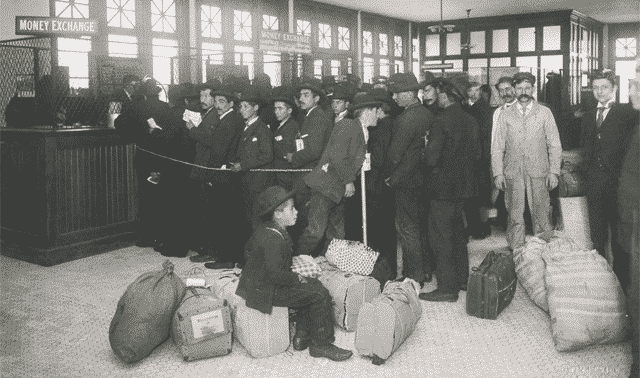
It was originally three separate islands. The current island is shaped like a "C", with two landmasses of equal size on the northeastern and southwestern sides, separated by what was formerly a ferry pier. It eventually obliterated the oyster beds, engulfed one of the Oyster Islands, and brought the shoreline much closer to the others. It also came from the railyards of the Lehigh Valley Railroad and the Central Railroad of New Jersey. The fill was acquired from the ballast of ships, as well as material excavated from the first line of the New York City Subway. In the late 19th century, the federal government began expanding the island by land reclamation to accommodate its immigration station, and the expansions continued until 1934. Ellis Island was one of three "Oyster Islands," the other two being Liberty Island and the now-subsumed Black Tom Island. Initially, much of the Upper New York Bay's western shore consisted of large tidal flats with vast oyster beds, which were a major source of food for the Lenape. Land expansion Įllis Island and Manhattan as seen from New Jersey shore in 2020

The island has been owned and administered by the federal government of the United States since 1808 and operated by the National Park Service since 1965. The artificial land is part of New Jersey. The natural island and contiguous areas comprise 4.68 acres (1.89 ha) within New York, and are located on the northern portion of the present-day island. The island has a land area of 27.5 acres (11.1 ha), much of which is from land reclamation. While most of the island is in Jersey City, New Jersey, a small section is an exclave of New York City. New York.Įllis Island is in Upper New York Bay, east of Liberty State Park and north of Liberty Island. Jurisdictional disputes between New Jersey and New York State persisted until the 1998 US Supreme Court ruling in New Jersey v. The 27.5-acre (11.1 ha) island was greatly expanded by land reclamation between the late 1890s and the 1930s. The main building and adjacent structures were completely renovated in 1990. After the immigration station's closure, the buildings languished for several years until they were partially reopened in 1976. During both World War I and World War II, its facilities were also used by the US military to detain prisoners of war. After 1924, Ellis Island was used primarily as a detention center for migrants.

The second station opened in 1900 and housed facilities for medical quarantines and processing immigrants. The first inspection station opened in 1892 and was destroyed by fire in 1897. In the 19th century, Ellis Island was the site of Fort Gibson and later became a naval magazine. The south side of the island, including the Ellis Island Immigrant Hospital, is open to the public only through guided tours.

The north side of the island is the site of the main building, now a national museum of immigration. Today, it is part of the Statue of Liberty National Monument and is accessible to the public only by ferry. From 1892 to 1954, nearly 12 million immigrants arriving at the Port of New York and New Jersey were processed there under federal law. states of New Jersey and New York, that was the busiest immigrant inspection and processing station in the United States. Ellis Island (the United States) Show map of the United StatesĮllis Island is a federally owned island in New York Harbor, situated within the U.S.


 0 kommentar(er)
0 kommentar(er)
